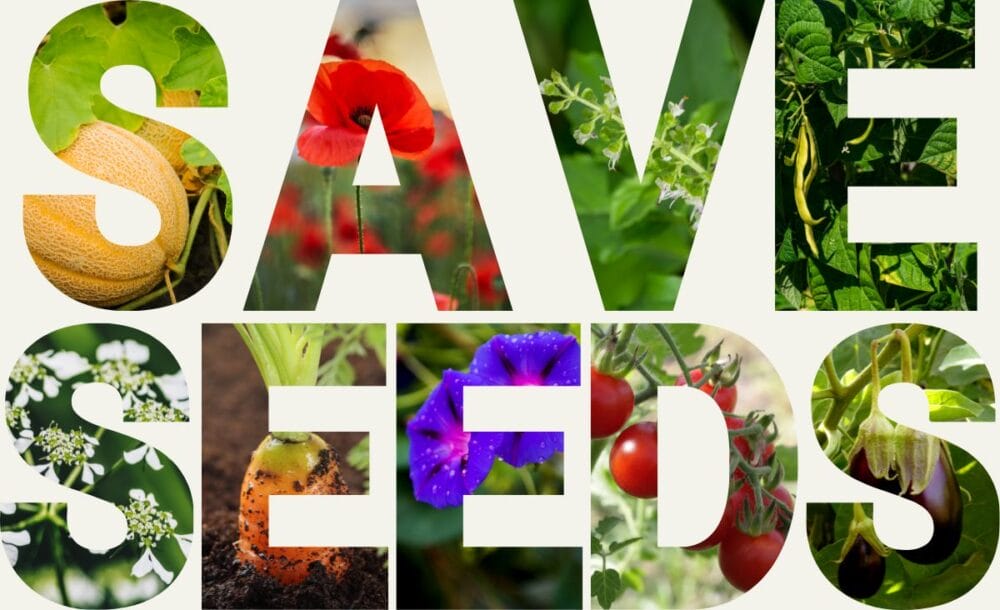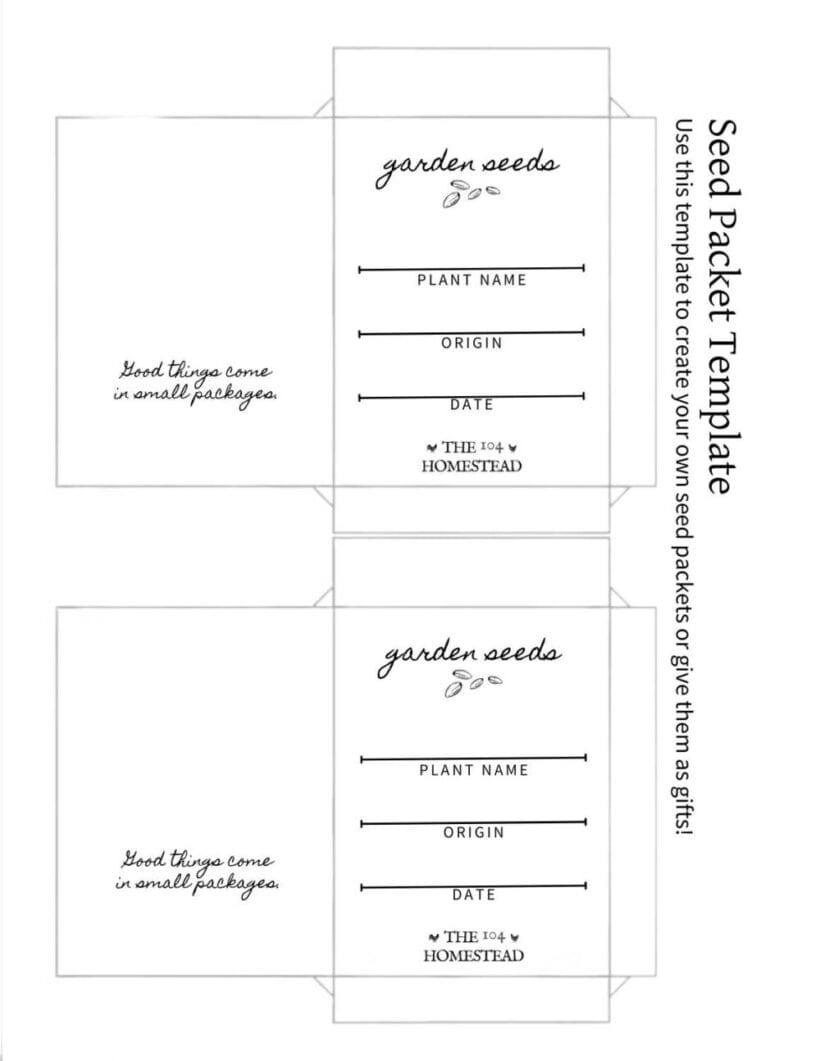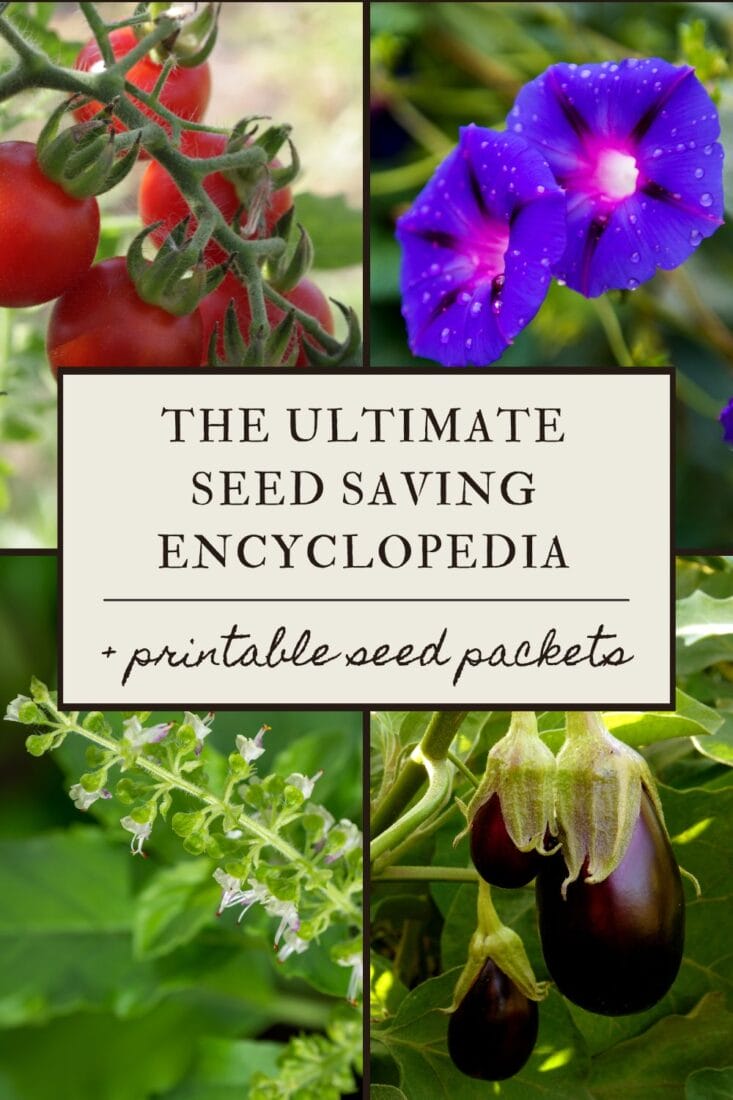An Encyclopedia of Seed Saving with Printable Seed Packets
A resource for everything you could need to know about seed saving, from vegetables to herbs to flowers. Learn how to save seeds properly.

Seed saving (also known as “brown-bagging”) is an amazing skill to learn. Not only do you save money and control the quality of your plants from year to year, but it’s a very rewarding step towards self-sufficiency. Imagine this: No dashing to the store to discover all of the “good tomato seeds” have been sold out for the season; No wondering if a particular variety will grow well in your area.
Do you grow garlic? You may already be practicing seed-saving baby steps! You select the best cloves from the previous year’s harvest for planting when you grow your own garlic. You save them until the next planting season. That’s the first step! Learning to save just one or two types of seeds each season is a great way to build skills without becoming overwhelmed. Rome wasn’t built in a day, and neither will your seed collection.
What is Brown Bagging?
Wait until the plant’s flowers have begun to die back, and clip the heads into a paper bag. Once the flower heads have dried, shake the bag, and you will see the seeds separate from the dried plant matter. Pick out the best seeds and store them in a printable seed packet or a pill bottle.

Tip: In humid climates, consider using desiccants like silica gel packs in seed storage containers to absorb excess moisture and maintain seed viability.
Saving Vegetable Seeds
Are you just getting started with seed saving? Below is a wonderful resource for everything you need to know about saving various types of seeds. Be sure to check back from time to time, as I will be continuously adding to the list.
Easy Seed Savers
The home gardener can most reliably save these seeds, even if you’ve never saved seeds before.
- Arugula Saving Arugula Seeds from GardenNerd
- Beans How to Save Bean Seeds from The Prairie Homestead
- Endive Batavian Seed Saving from Smart Gardener
- Lettuce Saving Lettuce Seeds from Urban Food Garden
- Leeks Grow Leeks to Save Leek Seeds from Homestead Lady
- Peas Saving Peas for Seed from Daughter of the Soil + Growing & Using Snow Peas from Homespun Seasonal Living
- Radishes Saving Seeds: Radish from Food Storage & Survival
- Tomatillos Saving Seed: Tomatillos from Cycle Farm
- Tomatoes How to Save Tomato Seeds from Homestead Lady
Intermediate Seed Savers
Some plants are biennials, which means they produce seeds in the second growing season. Many of these require large populations and isolation from things that could cross-pollinate with them.
- Asparagus Asparagus: The Garden Wonder from The Farmer’s Lamp
- Beets All About Growing Beets from Mother Earth News
- Bunching Onions Organic Bunching Onions – Growing and Seed Saving Info from High Mowing Organic Seeds
- Carrots How to Save Carrot Seeds from Food Storage & Survival
- Chard Organic Chard – Growing & Seed Saving Info from High Mowing Seeds
- Chili Peppers Saving Chili Pepper Seeds to Grow Again from The Chile Man
- Eggplant Saving Eggplant Seeds from The Southern Agrarian
- Parsnips All About Growing Parsnips from Mother Earth News
- Peppers Can You Use Seeds From a Bell Pepper to Plant? from HomeGuides
- Salsify Salsify Flower: Biennial Seed Saving Project from The Self-Sufficient HomeAcre
Hard Seed Savers
Some plants cross-pollinate; that means that if there is another variety around, they can pollinate each other, and the seeds you save will not be what you originally planted. These plants need to be isolated by large distances or hand-pollinated.
- Broccoli How To Save Broccoli Seeds In The Garden from Gardening Know How
- Brussel Sprouts Saving Brussel Sprout Seeds from Smart Gardener
- Cabbage Saving Cabbage Family Seeds from The Veggie Patch Reimagined
- Cauliflower Organic Cauliflower from High-Growing Seeds
- Corn How to Save Corn Seed from Weekend Gardener
- Cucumbers How to Save Cucumber Seeds from Your Garden from About Home
- Kale Saving Seeds from Kale from Wood Ridge Homestead
- Melons Saving Cantaloupe Seeds (applies to all melons) from Backyard Vegetable Gardening
- Pumpkins Raise Your Own Pumpkins from Farm Flavor
- Squash How to Save Squash Seeds from Capper’s Farmer
- Turnips Saving Turnip Seed from Going to Seed
Saving Herb Seeds
Herb seeds are typically easy to save using a “brown bag” method and rarely cross-pollinate. These are great for those who are just getting started.
- Basil How to Save Basil Seeds from The Dig In
- Chervil Herbs to Know: Chervil from Mother Earth Living
- Chives How to Save Chive Seeds from Mavis’ Garden Blog
- Cilantro/Coriander Harvesting Coriander Seeds from Vegetarian Times
- Dill Information on How to Harvest Dill from Gardening Know How
- Garlic Growing Garlic from Traditional Foods
- Lovage How to Grow Lovage from Plant Natural
- Marjoram How to Grow Marjoram from Heirloom Organics
- Oregano Oregano Plant Care from Folia
- Parsley Parsley Plant Guide from Smart Gardener
- Sage Saving Sage Seed from Growing Herbs for Beginners
- Salad Burnet How to Grow Salad Burnet from Gardening Know How
- Thyme Preserving Your Thyme Harvest from Preserving Your Harvest
Saving Flower Seeds
Flowers work in the same way as herbs do. They are typically easy to save by placing an organza bag or pantyhose over the flower head while it’s in the garden or brown beg them.
If they cross-pollinate or don’t breed true, it can often have some beautiful results and rarely cause any problems since most flowers are kept for ornamental purposes only. More care may need to be given if you are saving flowers for culinary or medicinal purposes.
- Bachelor Buttons How to Collect & Save Bachelor Button Seeds from Mr. Brown Thumb
- Calendula Calendula Seed Saving from Cedar Circle Farm
- Columbine Harvesting Columbine Seeds from In Bloom This Week
- Cleome Saving Seeds from Cleome from SFGate
- Lupines How to Save Lupine Seeds from eHow
- Marigolds How to Save Marigold Seed from Little *big* Harvest
- Milkweed Propagating Milkweeds from Borderlands Restoration
- Morning Glory How to Collect Morning Glory Seeds from Mr. Brown Thumb
- Nasturtium Collecting Nasturtium Seeds from The Nerdy Gardener
- Poppy Harvesting Poppy Seeds from Sincerely, Emily
- Sunflowers How to Plant & Grow Sunflowers from The Old Farmer’s Almanac
- Yarrow Harvesting Yarrow Seed from Hudman Honey Farm
Tip: To preserve genetic diversity, aim to save seeds from multiple plants within a species. This helps maintain a robust and adaptable plant population.
Frequently Asked Questions
If you’ve found value in this blog post and enjoyed reading it, why not share it with your Pinterest community? Pin the image below and spread the love!

Embracing the art of seed saving nurtures self-sufficiency and ensures a garden legacy that evolves with each passing season. From easy-to-save vegetable seeds for beginners to the meticulous process required for cross-pollinating varieties, the journey into seed preservation is fulfilling. So, gather your brown bags, explore the diverse world of seeds, and embark on a sustainable gardening odyssey, savoring the beauty of cultivating and preserving life from seed to harvest.
What’s your favorite seed-saving success story, or do you have any questions to share with the growing community? Your insights and experiences are the seeds that enrich our collective gardening wisdom!
